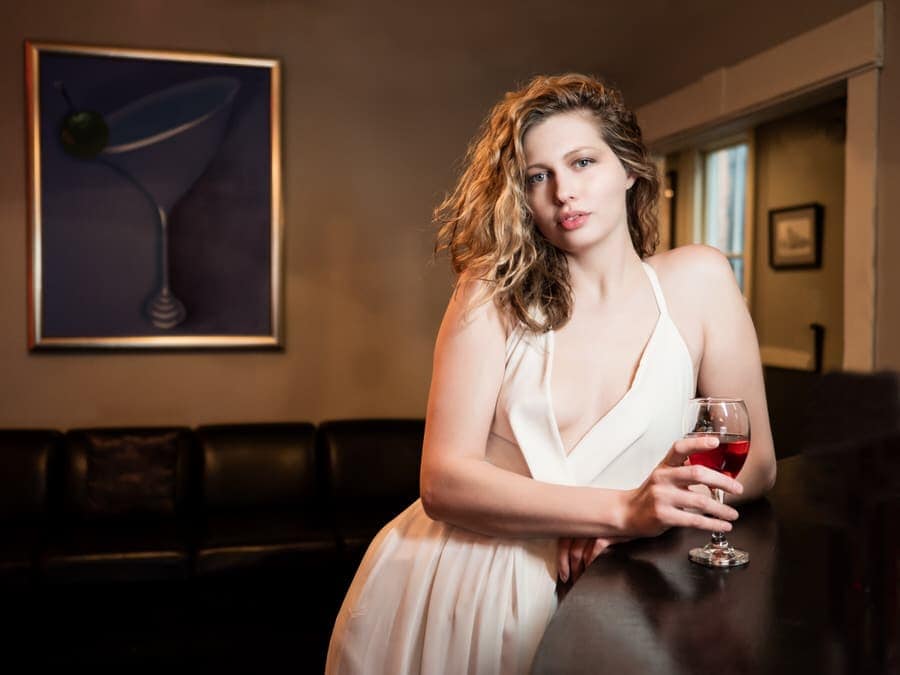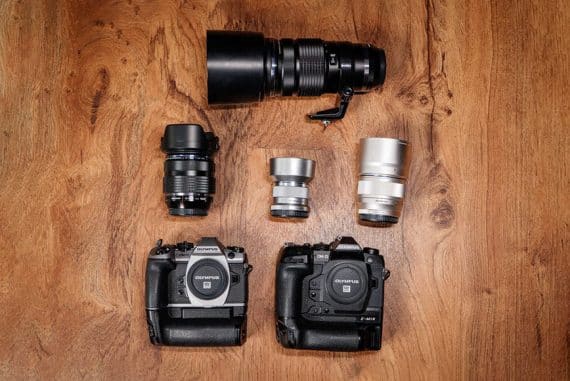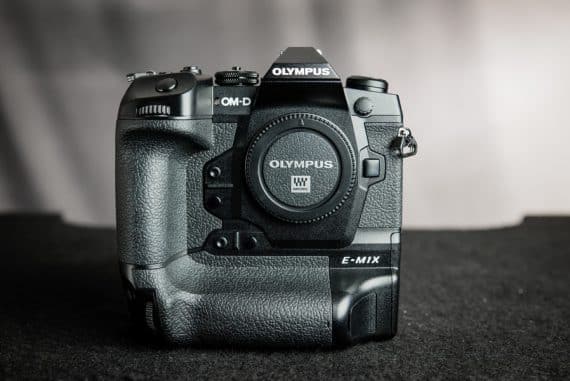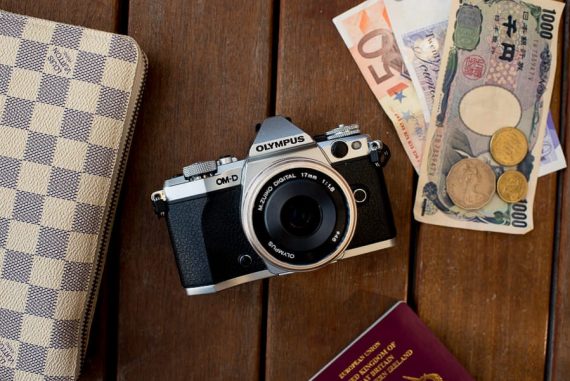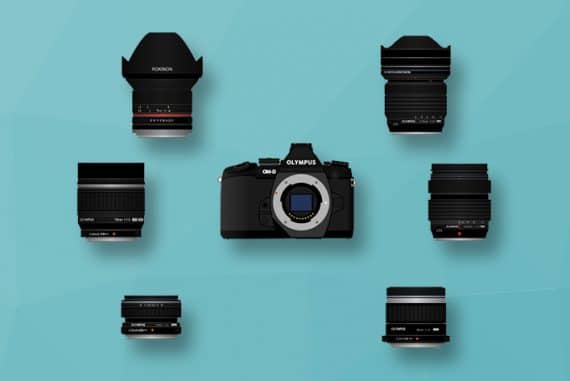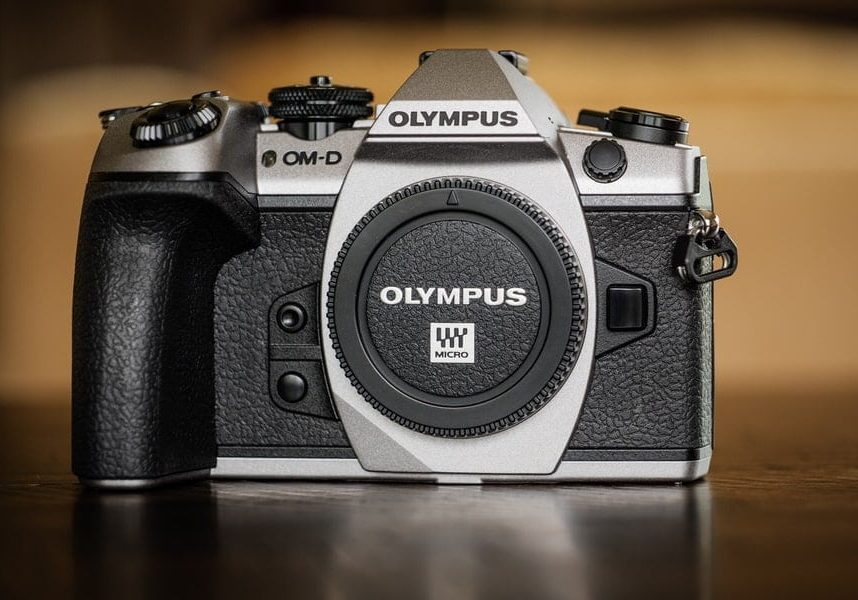
Olympus OMD EM1 II Camera Review
This is a guest review of the Olympus OMD EM1 II by wedding and portrait photographer Steve Vansak from Crown Point, Indiana.
The Olympus OMD EM1 II is the co flagship of the Olympus m4/3 lineup of professional mirrorless camera bodies along side the Olympus OMD EM1 X
. It is a 20.4 megapixel camera that shoots 15fps mechanical shutter, 18fps electronic shutter and a crazy 60fps in Pro Capture mode (a pre-buffering feature that saves images in continuity before the shutter is pressed).
As you can tell, this is a fantastic action shooting camera and even more so with Firmware 3/0 update which gives this camera the focusing system of the more sports oriented Olympus OMD EM1 X.
However, I am a wedding and portrait shooter so I will be writing about this camera from that perspective. Many will balk at the use of a crop sensor camera such as this for portraits and especially weddings.
However, it does hold some advantages for this genre you may not have thought of along with the downsides.
Let’s dig into what this camera system can and can’t do for you, should you decide to add it to your wedding and portrait toolbox.
Olympus OMD EM1 II Review | Crop Factor and DOF
- Compact and lightweight bodies and lenses.
- An abundant collection of excellent Pro (weather sealed) and Premium (non weather sealed lenses) from Olympus.
- A big selection of excellent lenses from Lumix (a m4/3 partner with Olympus) as well as Sigma and Leica and others.
- Weather sealed, tough and ergonomically sound body.
- Best IBIS among all of the camera manufacturers at 6.5 stops.
- Longer reach due to the 2x crop factor.
- Close up focusing ability.
- Fantastic options for lighting (compatible with Godox, Profoto, Elinchrom and more).
- -6 EV low light focusing with the 1.2 lenses.
- Dual SD card slots.
- More difficult to achieve shallow depth of field.
- No joystick for moving AF points (can use touch screen).
- High ISO performance is lacking compared to larger sensors.
- Busy bokeh with the f/2.8 lenses in certain situations.
- Confusing language within the menu system.
- The megapixel count is low for those who need / want to crop more.
The micro 4/3 system (from Olympus and Panasonic) has a 2x crop factor. This means that a micro 4/3 lens like the Olympus 17mm f/1.2 Pro lens used in the above image has an equivalent focal length in 35mm/full frame terms (from herein I will refer to this as ‘EFL’) of 34mm.
Shooting the lens at f/1.2 as I did in this shot will give it the depth of field of f/2.4. However, you will still get light gathering of f/1.2. This will enable you to keep your ISO values down and avoid noise.
The inability to get as shallow a depth of field as full frame sensors is one of the knocks on the system and I’m sure this is why Olympus has introduced an entire line of these f/1.2 Prime lenses such as the Olympus 25mm f/1.2 Pro lens (50mm EFL) and the Olympus 45mm f/1.2
Pro lens (90mm EFL) with more coming.
The lenses and the camera are incredibly fast focusing, even in very low light.
Handling and Ergonomics
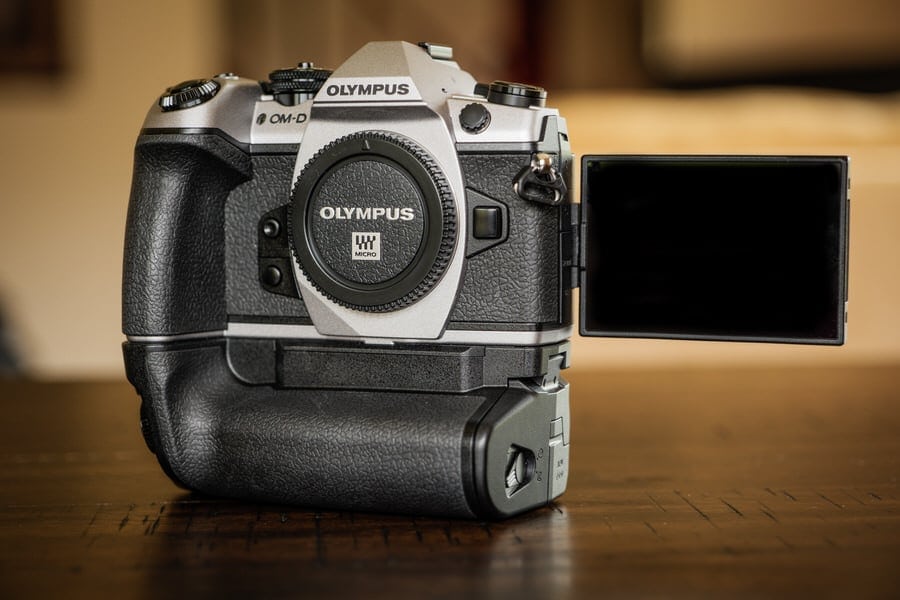
Olympus OMD EM1 II with battery grip and articulated screen.
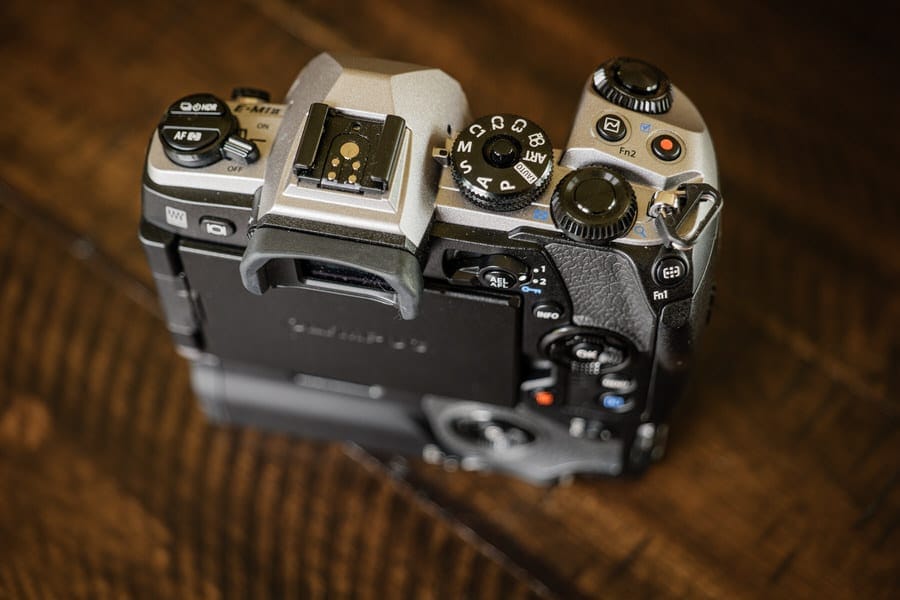
Olympus OMD EM1 II top plate and LCD flipped inward.
The Olympus OMD EM1 II has a nice deep grip and would make DSLR shooters feel right at home. The optional battery grip is always on the camera for me as I shoot very long events.
Unlike when mirrorless cameras first started out, battery life is fantastic on this Mark II version. I usually need to pop in one extra battery at the reception of a long wedding day and that is about it.
The marquee feature for wedding shooters is the optimal size and weight of both the bodies and the lenses.
If the weight and bulk of a full frame camera and 70-200 f/2.8 lens has you down (literally), you can easily replace it with this body plus the Olympus 40-150mm f/2.8 Pro lens, for 80-300mm range in equivalent full frame. You will get the light of f/2.8 but the depth of field of f/5.6 due to the crop sensor.
It’s a fantastic option for ceremonies where you need to be unobtrusive (the camera has silent shutter as well), but want tight images.
If you want to cream the background for wedding portraits of the bride though, you’d be better served with the Olympus 45mm f/1.2 Pro lens or a full frame system on your other hip.
The camera has tons of buttons and all are customizable to the point of overkill. You can literally make each button do more than a dozen tasks and there is even a 1-2 lever to instantly turn the camera into a totally different type of camera.
Shooting posed portraits in S-AF and then want to track action? Just set up your action settings on Lever 2 and instantly flip back and forth.
The back screen of the Olympus OMD EM1 II is full articulated and you can turn it around to see yourself for filming and also turn it inward to protect the screen when packing it away.
The custom settings (C1,C2, C3) on the mode dial are another quick way to jump to yet more quick set ups.
This takes away the need for menu diving and you will appreciate this because the menus here are deep.
After you spend some time with them you will get it, but they have so many options that it’s easy to get fatigued and tune out while going through them.
Weather Sealing
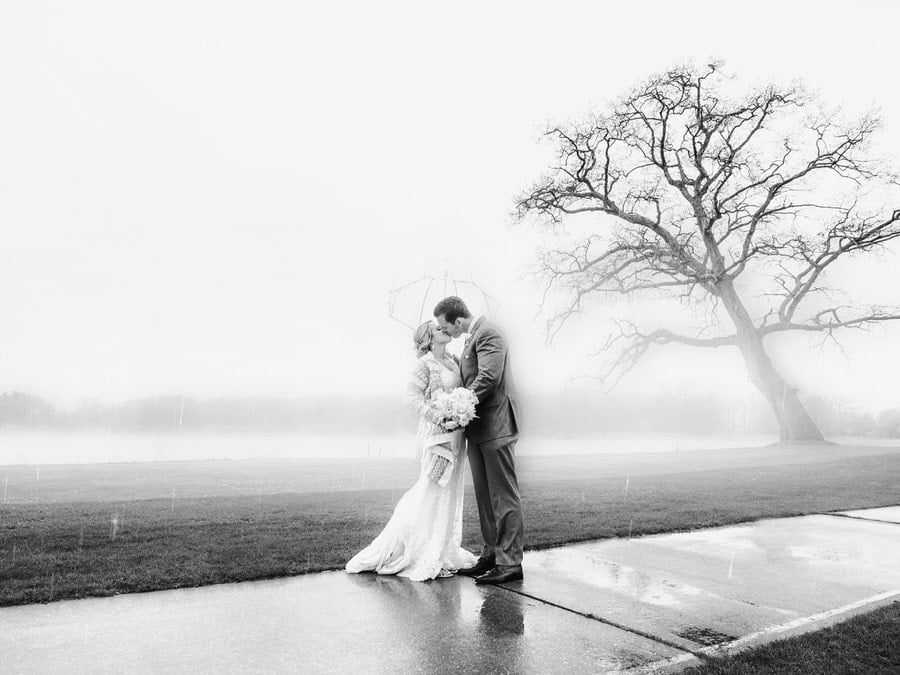
Olympus OMD EM1 II + Olympus 12-40mm f/2.8
Pro | 1/125 F4 ISO 200
I don’t think there are too many camera systems as fully weather sealed as the two flagships the Olympus OMD EM1 II or the Olympus OMD EM1 X
.
I took the above image in sleet and violent rain along with the Olympus 12-40mm f/2.8 Pro lens (EFL 24mm to 80mm) and I did not worry in the slightest about the gear…
I was definitely more concerned about my bride, but she was about as tough as this camera system.
Low Light Performance and High ISO
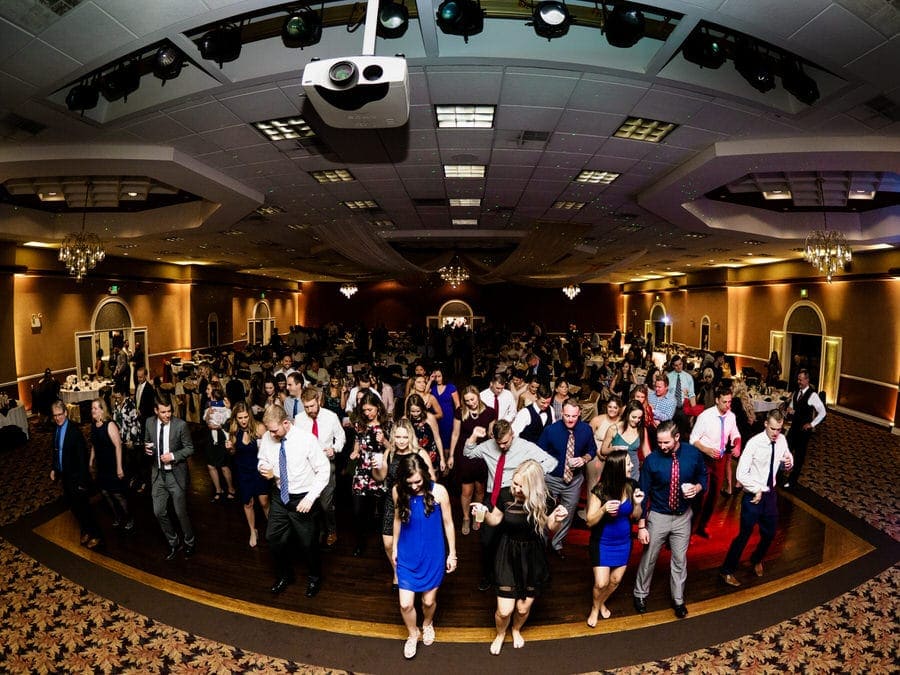
Olympus OMD EM1 II + Olympus 8mm f/1.8
Pro | 1/100 F1.8 ISO 3200
The Olympus OMD EM1 II has a native ISO range of 200-6400 expandable from 64-25,800.
Let’s face it, most clients do not notice noise. Expression beats perfection in their minds whether it be weddings or other events.
However, you the photographer must please yourself too. Depending on your noise tolerance, I would stick to ISO 3200 and below for best results and ISO 6400 only when necessary.
Keep in mind though, the fast prime line up with lenses like the Olympus 25mm f/1.2 Pro lens (a 50mm EFL) will enable you to keep your ISO in these comfortable ranges.
Quick tip:
Whether shooting this crop sensor system at high ISO or any other system, it’s best to expose to the right and bring the image exposure down in post. This really helps in keeping images clean of image noise and is especially beneficial to the m4/3 system.
Hidden Benefits of the Olympus OMD EM1 II

Olympus OMD EM1 II + Leica 42.5mm f/1.2 | Image left – 1/60 F11 ISO 200 | Image right – 1/100 F1.2 ISO 200
The m4/3 system has as its name implies a 4:3 aspect ratio. This is quite beneficial for wedding and portrait shooters for a couple of reasons:
- It takes away the maddeningly bad habit of photographers to leave way too much headroom in their vertical images.
- This aspect ratio also fits into more print sizes such as 8×10 without losing too much. When clients order via the online gallery or during in person sales, no more having to explain why the print is cutting off people on the edge.
While the 2x crop sensor is a deal breaker for some as they want the best high ISO performance and the shallowest of depth of field they can achieve, it does allow for lenses and bodies to be a fraction of the size and weight, resulting in healthier backs for wedding photographers and more room in the camera bag.
It is also even possible (gasp) to have both systems in place and get the best of both worlds.
For travelers and hikers I think the Olympus OMD EM1 II
is the best camera system for sure. For the wedding and portrait crowd, it will really depend upon your needs/wants.
Just about all of the lenses in the Olympus system have close up focusing ability enabling a wedding shooter to get great detail shots.
While there are dedicated macro lenses such as the ultra affordable Olympus 30mm f/3.5 Macro (60mm EFL) and the Olympus 60mm f/2.8
Macro Pro (120mm EFL) available, the regular lenses such as the Olympus 17mm f/1.2
Pro (34mm EFL) offer fantastic close up focusing and most wedding shooters can skip the addition of a dedicated macro lens.
Olympus’ biggest claim to fame here is the astounding IBIS. You can rack out to 300mm EFL on the Olympus 40-150mm f/2.8 Pro lens (80-300mm EFL) and shoot at ridiculously slow shutter speeds like 1/8 of a second if need be.
For wedding photography with moving subjects you will probably never be that slow, but the point being that blurry images from camera shake are a thing of the past with this camera.
Improvements Needed

Olympus OMD EM1 II + Olympus 12-40mm f/2.8
lens | 1/200 F4 ISO 400
The Olympus OMD EM1 II is a great camera system for wedding and portrait photographers but the following improvements could go a long way toward making these shooters’ lives easier.
- A Mark III version could use an AF joystick for moving AF points around.
- The Olympus EM1 X
has fantastic AI deep learning for tracking motorsports. An OMD EM1 III could use better face / eye tracking and be the more portrait oriented of the two flagships.
- The f/2.8 Pro Zooms are fantastically sharp but even faster zoom options could help with keeping ISO settings lower as well as shallower depth of field. Sometimes the Olympus 12-40mm f/2.8
Pro lens (24-80 EFL) and the Olympus 40-150mm f/2.8
Pro lens (80-300 EFL) produce some busy bokeh in certain situations. Having a far away background helps, but not always available at a wedding. I’m thinking lenses like a 10-25mm f/1.4 or 25-75mm f/1.4 type of lens.
- The EVF and LCD are beginning to show their age as much higher resolution options are now on the market.
Olympus OMD EM1 II | Conclusion

Olympus OMD EM1 II Silver Anniversary Edition
While the Olympus OMD EM1 II has the smaller m4/3 sensor inside, it is very much a professional camera.
Show up to a wedding with the class-leading IBIS of the body combined with the bevy of f/1.2 Pro lenses, and it more than makes up for the smaller sensor.
The smaller and lighter body and lenses make for a much more portable system that will allow you to go the distance at a long wedding as well travel or hike with.
The top notch weather sealing means the camera is ready for anything mother nature may throw at it.
I’ve built my business upon using this camera as well as its predecessor as my sole wedding photography system. While I’ve since added a full frame camera and lenses because I recognize different tools for different situations, I’d have no problem recommending the Olympus OMD EM1 II
and its accompanying lenses as a wedding and portrait camera system.
However, I suggest renting one to try to make sure that your own personal threshold for image noise and images with shallow depth of field can be met.
I think you will be pleasantly surprised how well this camera will do for you.





